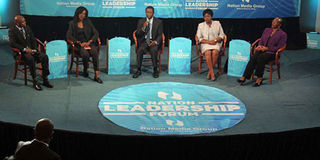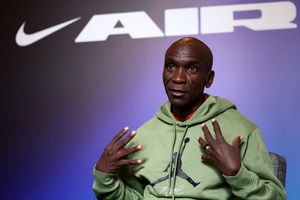Level the ground for women in newsrooms

Panellists drawn from various industries discuss gender equality during the Nation Leadership Forum at the University of Nairobi on December 7, 2017. Newsrooms must employ human resource policies that will ensure that the gender principle is realised. PHOTO | FILE | NATION MEDIA GROUP
What you need to know:
- Having more women at the helm of media leadership and management serves as a catalyst for younger generations to consider, seek and aspire to attain leadership roles in future.
- We must be deliberate about creating safe spaces for women in the newsrooms to talk about the challenges they face as they execute their roles.
The journey towards the realisation of the two-thirds gender principle in this country has been loud, bumpy, messy and with casualties.
According to the National Gender and Equality Commission (NGEC), it is a journey that has been punctuated with epic highs and lows that morphed into one of the most heavily debated and contentious issues after the adoption of the 2010 Constitution.
In a recently released report titled “Journey to Gender Parity in Political Representation”, NGEC examines the cautious yet bold consultative framework through the Technical Working Group that sought to broker a practical and politically sound formula for the realisation of the gender principle as enshrined in Article 27 of the Constitution.
The accounts range from both hard to soft lobbying tactics deployed to various influencers.
It exposes the initial naivety that the Technical Working Group strode while seeking a framework within the shortest time possible. Some have termed it a battle of the sexes, a warfare of genders laced with patriarchy.
INSPIRE
The media landscape is not any different. Very few women are part of the editorial decision-making in the region, and even when they are present they are often outnumbered at the decision-making table.
The Graduate School of Media and Communications at Aga Khan University in Nairobi recently held a meeting featuring seasoned media leaders from various media houses and organisations in Kenya.
Panellists discussed the status of women in media leadership in Kenya, interrogating whether women in the media have “broken the glass ceilings, brought down the concrete walls, and learnt to walk on sticky floors”.
According to Dr Nancy Booker, the director of academic affairs at the school, having more women at the helm of media leadership and management serves as a catalyst for younger generations to consider, seek and aspire to attain leadership roles in future.
BALANCE
Here proposals that might just work. Newsrooms must employ human resource policies that will ensure that the gender principle is realised.
This means, while hiring, all panellists during the interview are aware of the existing demographics and ensure that a balance is achieved.
We must be deliberate on making the newsroom a conducive working environment for women.
This includes enactment of policies that ensure protection and safety of women against sexual harassment, intimidation and unnecessary threats, plus contractual protection that will see women advance a balance between jobs and their family goals, including paid parental leave policies.
How many newsrooms have baby crèches? How many newsrooms have flexible working hours for nursing mothers?
Any newsroom with infant-at-work programmes? How many newsrooms have parking spaces for pregnant women?
DECISION-MAKING
We must be deliberate about having more women sitting at the decision-making table. It is not enough to have women sitting at the table and nodding.
Their ideas, concerns and thoughts have to be given the same weight as the men sitting at the table. Women who are at the top must make a deliberate move to grow those coming behind them.
We must be deliberate about creating safe spaces for women in the newsrooms to talk about the challenges they face as they execute their roles.
The challenges that deter women from climbing the ladder in the media are historical as well as institutional.
We must be bold enough to call out the practices and work structures that make it twice as hard for women to deliver as required, and then pay them less than what is paid to men for equivalent work done.
The Constitution provides a solid ground for entrenching the principles of equality and inclusion in all spheres of life. This must be respected as irreducible minimum.
The writer is a journalist and an officer at the Kenya National Commission on Human Rights.





